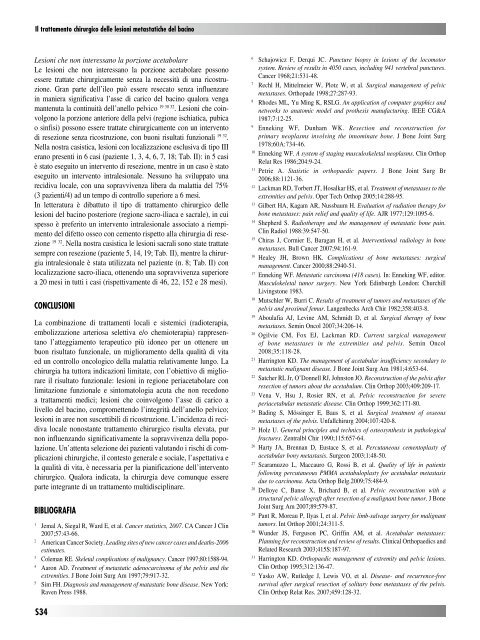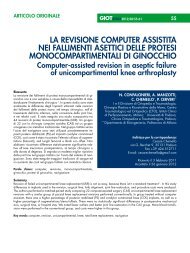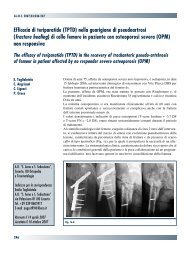30845 Suppl Giot.pdf - Giornale Italiano di Ortopedia e Traumatologia
30845 Suppl Giot.pdf - Giornale Italiano di Ortopedia e Traumatologia
30845 Suppl Giot.pdf - Giornale Italiano di Ortopedia e Traumatologia
You also want an ePaper? Increase the reach of your titles
YUMPU automatically turns print PDFs into web optimized ePapers that Google loves.
Il trattamento chirurgico delle lesioni metastatiche del bacino<br />
Lesioni che non interessano la porzione acetabolare<br />
Le lesioni che non interessano la porzione acetabolare possono<br />
essere trattate chirurgicamente senza la necessità <strong>di</strong> una ricostruzione.<br />
Gran parte dell’ileo può essere resecato senza influenzare<br />
in maniera significativa l’asse <strong>di</strong> carico del bacino qualora venga<br />
mantenuta la continuità dell’anello pelvico 19 30 32 . Lesioni che coinvolgono<br />
la porzione anteriore della pelvi (regione ischiatica, pubica<br />
o sinfisi) possono essere trattate chirurgicamente con un intervento<br />
<strong>di</strong> resezione senza ricostruzione, con buoni risultati funzionali 19 32 .<br />
Nella nostra casistica, lesioni con localizzazione esclusiva <strong>di</strong> tipo III<br />
erano presenti in 6 casi (paziente 1, 3, 4, 6, 7, 18; Tab. II): in 5 casi<br />
è stato eseguito un intervento <strong>di</strong> resezione, mentre in un caso è stato<br />
eseguito un intervento intralesionale. Nessuno ha sviluppato una<br />
reci<strong>di</strong>va locale, con una sopravvivenza libera da malattia del 75%<br />
(3 pazienti/4) ad un tempo <strong>di</strong> controllo superiore a 6 mesi.<br />
In letteratura è <strong>di</strong>battuto il tipo <strong>di</strong> trattamento chirurgico delle<br />
lesioni del bacino posteriore (regione sacro-iliaca e sacrale), in cui<br />
spesso è preferito un intervento intralesionale associato a riempimento<br />
del <strong>di</strong>fetto osseo con cemento rispetto alla chirurgia <strong>di</strong> resezione<br />
19 32 . Nella nostra casistica le lesioni sacrali sono state trattate<br />
sempre con resezione (paziente 5, 14, 19; Tab. II), mentre la chirurgia<br />
intralesionale è stata utilizzata nel paziente (n. 8; Tab. II) con<br />
localizzazione sacro-iliaca, ottenendo una sopravvivenza superiore<br />
a 20 mesi in tutti i casi (rispettivamente <strong>di</strong> 46, 22, 152 e 28 mesi).<br />
CONCLuSIONI<br />
La combinazione <strong>di</strong> trattamenti locali e sistemici (ra<strong>di</strong>oterapia,<br />
embolizzazione arteriosa selettiva e/o chemioterapia) rappresentano<br />
l’atteggiamento terapeutico più idoneo per un ottenere un<br />
buon risultato funzionale, un miglioramento della qualità <strong>di</strong> vita<br />
ed un controllo oncologico della malattia relativamente lungo. La<br />
chirurgia ha tuttora in<strong>di</strong>cazioni limitate, con l’obiettivo <strong>di</strong> migliorare<br />
il risultato funzionale: lesioni in regione periacetabolare con<br />
limitazione funzionale e sintomatologia acuta che non recedono<br />
a trattamenti me<strong>di</strong>ci; lesioni che coinvolgono l’asse <strong>di</strong> carico a<br />
livello del bacino, compromettendo l’integrità dell’anello pelvico;<br />
lesioni in aree non suscettibili <strong>di</strong> ricostruzione. L’incidenza <strong>di</strong> reci<strong>di</strong>va<br />
locale nonostante trattamento chirurgico risulta elevata, pur<br />
non influenzando significativamente la sopravvivenza della popolazione.<br />
Un’attenta selezione dei pazienti valutando i rischi <strong>di</strong> complicazioni<br />
chirurgiche, il contesto generale e sociale, l’aspettativa e<br />
la qualità <strong>di</strong> vita, è necessaria per la pianificazione dell’intervento<br />
chirurgico. Qualora in<strong>di</strong>cata, la chirurgia deve comunque essere<br />
parte integrante <strong>di</strong> un trattamento multi<strong>di</strong>sciplinare.<br />
BIBLIOGraFIa<br />
1 Jemal A, Siegal R, Ward E, et al. Cancer statistics, 2007. CA Cancer J Clin<br />
2007;57:43-66.<br />
2 American Cancer Society. Lea<strong>di</strong>ng sites of new cancer cases and deaths-2006<br />
estimates.<br />
3 Coleman RE. Skeletal complications of malignancy. Cancer 1997;80:1588-94.<br />
4 Aaron AD. Treatment of metastatic adenocarcinoma of the pelvis and the<br />
extremities. J Bone Joint Surg Am 1997;79:917-32.<br />
5 Sim FH. Diagnosis and management of matastatic bone <strong>di</strong>sease. New York:<br />
Raven Press 1988.<br />
S34<br />
6 Schajowicz F, Derqui JC. Puncture biopsy in lesions of the locomotor<br />
system. Review of results in 4050 cases, inclu<strong>di</strong>ng 941 vertebral punctures.<br />
Cancer 1968;21:531-48.<br />
7 Rechl H, Mittelmeier W, Plotz W, et al. Surgical management of pelvic<br />
metastases. Orthopade 1998;27:287-93.<br />
8 Rhodes ML, Yu Ming K, RSLG. An application of computer graphics and<br />
networks to anatomic model and prothesis manufacturing. IEEE CG&A<br />
1987;7:12-25.<br />
9 Enneking WF, Dunham WK. Resection and reconstruction for<br />
primary neoplasms involving the innominate bone. J Bone Joint Surg<br />
1978;60A:734-46.<br />
10 Enneking WF. A system of staging musculoskeletal neoplasms. Clin Orthop<br />
Relat Res 1986;204:9-24.<br />
11 Petrie A. Statistic in orthopae<strong>di</strong>c papers. J Bone Joint Surg Br<br />
2006;88:1121-36.<br />
12 Lackman RD, Torbert JT, Hosalkar HS, et al. Treatment of metastases to the<br />
extremities and pelvis. Oper Tech Orthop 2005;14:288-95.<br />
13 Gilbert HA, Kagam AR, Nussbaum H. Evaluation of ra<strong>di</strong>ation therapy for<br />
bone metastases: pain relief and quality of life. AJR 1977;129:1095-6.<br />
14 Shepherd S. Ra<strong>di</strong>otherapy and the management of metastatic bone pain.<br />
Clin Ra<strong>di</strong>ol 1988:39:547-50.<br />
15 Chiras J, Cormier E, Baragan H, et al. Interventional ra<strong>di</strong>ology in bone<br />
metastases. Bull Cancer 2007;94:161-9.<br />
16 Healey JH, Brown HK. Complications of bone metastases: surgical<br />
management. Cancer 2000;88:2940-51.<br />
17 Enneking WF. Metastatic carcinoma (418 cases). In: Enneking WF, e<strong>di</strong>tor.<br />
Musculokeletal tumor surgery. New York E<strong>di</strong>nburgh London: Churchill<br />
Livingstone 1983.<br />
18 Mutschler W, Burri C. Results of treatment of tumors and metastases of the<br />
pelvis and proximal femur. Langenbecks Arch Chir 1982;358:403-8.<br />
19 Aboulafia AJ, Levine AM, Schmidt D, et al. Surgical therapy of bone<br />
metastases. Semin Oncol 2007;34:206-14.<br />
20 Ogilvie CM, Fox EJ, Lackman RD. Current surgical management<br />
of bone metastases in the extremities and pelvis. Semin Oncol<br />
2008;35:118-28.<br />
21 Harrington KD. The management of acetabular insufficiency secondary to<br />
metastatic malignant <strong>di</strong>sease. J Bone Joint Surg Am 1981;4:653-64.<br />
22 Satcher RL Jr, O’Donnell RJ, Johnston JO. Reconstruction of the pelvis after<br />
resection of tumors about the acetabulum. Clin Orthop 2003;409:209-17.<br />
23 Vena V, Hsu J, Rosier RN, et al. Pelvic reconstruction for severe<br />
periacetabular metastatic <strong>di</strong>sease. Clin Orthop 1999;362:171-80.<br />
24 Ba<strong>di</strong>ng S, Mössinger E, Baus S, et al. Surgical treatment of osseous<br />
metastases of the pelvis. Unfallchirurg 2004;107:420-8.<br />
25 Holz U. General principles and technics of osteosynthesis in pathological<br />
fractures. Zentralbl Chir 1990;115:657-64.<br />
26 Harty JA, Brennan D, Eustace S, et al. Percutaneous cementoplasty of<br />
acetabular bony metastasis. Surgeon 2003;1:48-50.<br />
27 Scaramuzzo L, Maccauro G, Rossi B, et al. Quality of life in patients<br />
following percutaneous PMMA acetabuloplasty for acetabular metastasis<br />
due to carcinoma. Acta Orthop Belg.2009;75:484-9.<br />
28 Delloye C, Banse X, Brichard B, et al. Pelvic reconstruction with a<br />
structural pelvic allograft after resection of a malignant bone tumor. J Bone<br />
Joint Surg Am 2007;89:579-87.<br />
29 Pant R, Moreau P, Ilyas I, et al. Pelvic limb-salvage surgery for malignant<br />
tumors. Int Orthop 2001;24:311-5.<br />
30 Wunder JS, Ferguson PC, Griffin AM, et al. Acetabular metastases:<br />
Planning for reconstruction and review of results. Clinical Orthopae<strong>di</strong>cs and<br />
Related Research 2003;415S:187-97.<br />
31 Harrington KD. Orthopae<strong>di</strong>c management of extremity and pelvic lesions.<br />
Clin Orthop 1995;312:136-47.<br />
32 Yasko AW, Rutledge J, Lewis VO, et al. Disease- and recurrence-free<br />
survival after surgical resection of solitary bone metastases of the pelvis.<br />
Clin Orthop Relat Res. 2007;459:128-32.

















